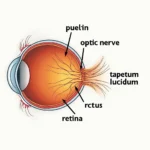Have you ever wondered, “De qué color son los patos?” While the immediate answer might be “yellow” thanks to our cartoon friends, the reality is far more diverse and fascinating. Ducks, members of the Anatidae family, boast a stunning array of colors and patterns in their plumage, from the vibrant greens and blues of mallards to the intricate markings of wood ducks.
Beyond Yellow: Unveiling the Spectrum of Duck Colors
Duck coloration is influenced by several factors, including species, sex, age, and even the time of year.
- Species: Each duck species has evolved unique plumage to suit its environment and lifestyle. For example, the Mallard, a common sight in parks and ponds, sports a striking emerald green head, while the Northern Pintail flaunts a long, pointed tail and a subtle gray and brown pattern.
- Sexual Dimorphism: In many duck species, males and females exhibit distinct differences in coloration. This phenomenon, known as sexual dimorphism, often results in more vibrant and eye-catching plumage for males, particularly during the breeding season. For instance, the male Wood Duck dazzles with a multicolored crest, while the female displays more subdued brown and gray tones.
- Age: Just like teenagers undergoing growth spurts, young ducks, also known as ducklings, typically have duller plumage compared to their adult counterparts. This camouflage helps protect them from predators until they develop their adult feathers.
- Seasonal Changes: Some duck species undergo a dramatic transformation in their plumage depending on the time of year. During the breeding season, males often sport their most vibrant colors to attract mates. As winter approaches, many ducks molt into a more subdued plumage known as “eclipse plumage,” which helps them blend into their surroundings and avoid predators.
From Drab to Dazzling: The Science Behind Duck Colors
The captivating colors of duck feathers arise from a combination of pigments and structural properties.
- Melanin: This pigment, responsible for the browns, blacks, and reddish hues in many animals, also plays a role in duck coloration.
- Carotenoids: These pigments, obtained through a duck’s diet, produce vibrant yellows, oranges, and reds. The more carotenoids a duck consumes, the brighter its plumage.
- Structural Coloration: Beyond pigments, the microscopic structure of feathers can also influence their appearance. Tiny air pockets and ridges within the feathers scatter light, creating iridescent effects. This is why some duck feathers, like those of the Mallard, shimmer with greens and blues depending on the angle of light.
Duck Colors in Our World: Beyond the Pond
The vibrant hues and patterns of duck plumage have captivated humans for centuries, inspiring art, literature, and even fashion.
- Art and Literature: From ancient Egyptian hieroglyphs to children’s books, ducks have held a prominent place in art and literature, often depicted with their characteristic yellow bills and colorful feathers.
- Fashion and Design: Duck feather patterns, particularly the iconic mallard pattern, have made their way into fashion and design, appearing on everything from clothing and accessories to home decor.
Frequently Asked Questions about Duck Colors
Q: Why are baby ducks yellow?
A: While not all ducklings are bright yellow, many species, such as Mallards, have yellow down feathers for camouflage and protection.
Q: Do ducks change color as they get older?
A: Yes, many duck species undergo plumage changes throughout their lives. Ducklings have duller plumage, while adults develop their characteristic colors, with males often displaying brighter hues, especially during breeding season.
Q: What do ducks eat to get their colors?
A: A duck’s diet, particularly its intake of carotenoid-rich foods like insects, crustaceans, and aquatic plants, influences the vibrancy of its plumage.
Exploring the Wonderful World of Ducks
“De qué color son los patos?” The answer is far more captivating than a single hue. From the shimmering greens of mallards to the intricate patterns of wood ducks, duck plumage reveals a fascinating world of natural beauty and adaptation. As you observe these feathered creatures in their natural habitats, take a moment to appreciate the diversity and wonder of their colorful world.
Need help identifying a particular duck species or want to learn more about these fascinating creatures? Contact our team of experts at [Phone number] or email us at [Email address]. We’re here to help you explore the wonders of the natural world!

